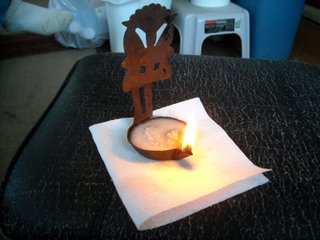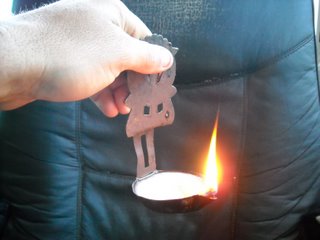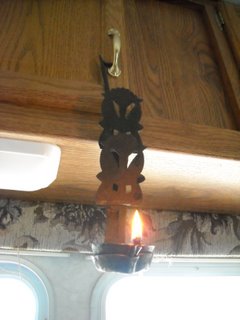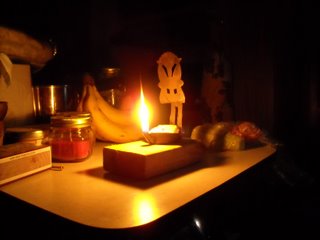In continuing on a path to the old ways, we are hoping to lessen our reliance upon electricity, which for us right now includes producing light. Typically in the old days light was generated by burning oil (Lev 24:2; Ex 39:37). Interestingly, one of the oils people would use was lard from animals. We have the rendered fat from our pigs that have been butchered; and so, I thought it might be interesting to see if using the lard might work for us.
I discovered that there are things that exist called “fat lamps”, and so I purchased one from over the Internet that was a double, hanging lamp. These don’t have a wick, but apparently a strings from a mop head can be used, a couple of which the neighbors gave me. I put a large tablespoon worth of lard in the little “pan” of the lamp, took a mop string and put it in the lard so that it would be completely covered (the lard needs to be melted just enough to do this), put the lard-coated wick in the spout of the lamp, and lit it. It worked!…sort of — it had a very small flame. I found that if I positioned the wick to stick up in the air a little like a candle, it worked much better. The lard melted as the wick burned; the wick became saturated; and with as much lard as we used, the flame lasted for about three hours.
Here are some pictures of it in action:
Here it is, set in its hanging partner lamp:
After the first test where all of the lard was used, I wanted to see if by just adding more lard the lamp would continue to work. And so, I took another bit of lard and put it in the lamp, trimmed the wick and repositioned it, and then lit it. It was soaked enough with the previous lard that it worked fine; and then as the new lard melted, the lamp continued to burn.
Here it is re-lit, and at night with the electric lights off:
We are thankful for the Lord showing us ways to do things that are fashioned from His direct provisions.
— David




Wow that works great.. do you know if you can use this in a normal lamp that would take oil?
Debylin
Deb, I tried it and didn’t have any success.
David, check out this link:
http://www.steve-adler.com/OilLampsMain.htm
My sister’s a potter and I’m going to see if I can get her to make some of these designs.
Ya’ll have that wonderful native clay and when I found this site it was the first thing I thought of.
Judy
Thank you both. I asked Michael, and he suggested because the lard is too viscous to travel up the wick. I did make a little wire wick holder yesterday that’s about an 1 1/4 to 1 1/2 inches tall, and using the other mop string and putting them in a mason jar, it worked with the lard, although I had to thoroughly coat the wick initially in the lard, which meant the lard had to be sort of melted. I used my fingers, and the body heat helped melt the lard while coating the wick.
Also, thank you for the Web site Judy. Might just have to try making one ourselves one day.
— David
I confess that I read the post twice and came away wondering what on earth THAT had to do with getting a flat tire on the road to agrarianism! Had a nice chuckle at myself and really enjoyed the post. My wife and I have seen these in Lehman’s and wondered about them. Now we know! We are going to try the mason jar method with some lard we rendered last month! Many thanks!
Hello Pilgrim Pundit and thank you.
I tried taking some baling wire and fashioning it into a little wick holder similar to the Lehman’s one, and it worked well, although the only mason jars we have have no handles. Still, it was cheaper than buying one. And it was pretty easy; you can search the Internet for how to make a wire oil lamp wick holder. I just tried to make sure the coil didn’t stick up too much so it would be closer to the lard at the bottom, although I suppose if you keep enough lard in the jar, that might not be as important.
— David